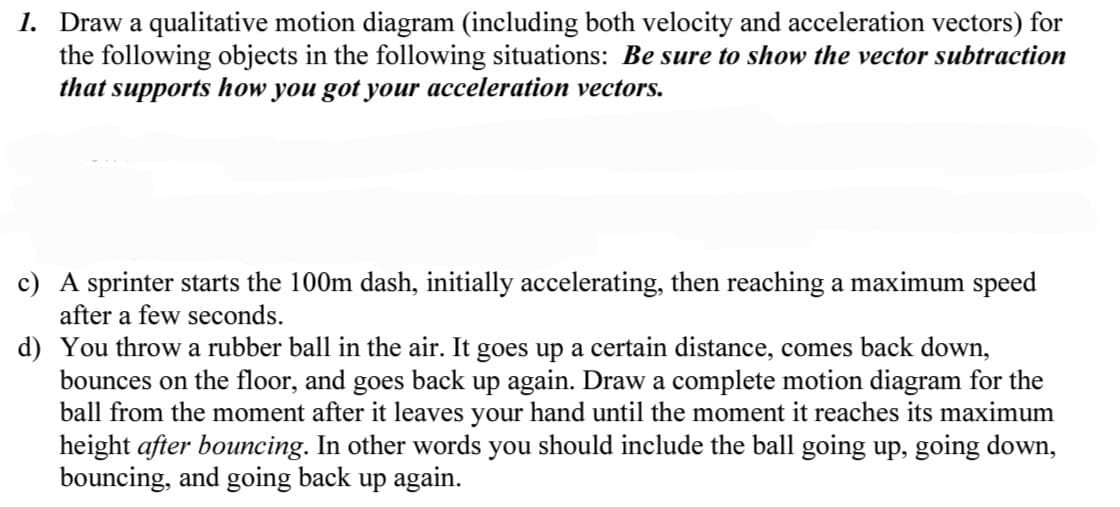1. Draw a qualitative motion diagram (including both velocity and acceleration vectors) for the following objects in the following situations: Be sure to show the vector subtraction that supports how you got your acceleration vectors. c) A sprinter starts the 100m dash, initially accelerating, then reaching a maximum speed after a few seconds. d) You throw a rubber ball in the air. It goes up a certain distance, comes back down, bounces on the floor, and goes back up again. Draw a complete motion diagram for the ball from the moment after it leaves your hand until the moment it reaches its maximum height after bouncing. In other words you should include the ball going up, going down, bouncing, and going back up again.
1. Draw a qualitative motion diagram (including both velocity and acceleration vectors) for the following objects in the following situations: Be sure to show the vector subtraction that supports how you got your acceleration vectors. c) A sprinter starts the 100m dash, initially accelerating, then reaching a maximum speed after a few seconds. d) You throw a rubber ball in the air. It goes up a certain distance, comes back down, bounces on the floor, and goes back up again. Draw a complete motion diagram for the ball from the moment after it leaves your hand until the moment it reaches its maximum height after bouncing. In other words you should include the ball going up, going down, bouncing, and going back up again.
Applications and Investigations in Earth Science (9th Edition)
9th Edition
ISBN:9780134746241
Author:Edward J. Tarbuck, Frederick K. Lutgens, Dennis G. Tasa
Publisher:Edward J. Tarbuck, Frederick K. Lutgens, Dennis G. Tasa
Chapter1: The Study Of Minerals
Section: Chapter Questions
Problem 1LR
Related questions
Question

Transcribed Image Text:1. Draw a qualitative motion diagram (including both velocity and acceleration vectors) for
the following objects in the following situations: Be sure to show the vector subtraction
that supports how you got your acceleration vectors.
c) A sprinter starts the 100m dash, initially accelerating, then reaching a maximum speed
after a few seconds.
d) You throw a rubber ball in the air. It goes up a certain distance, comes back down,
bounces on the floor, and goes back up again. Draw a complete motion diagram for the
ball from the moment after it leaves your hand until the moment it reaches its maximum
height after bouncing. In other words you should include the ball going up, going down,
bouncing, and going back up again.
Expert Solution
This question has been solved!
Explore an expertly crafted, step-by-step solution for a thorough understanding of key concepts.
Step by step
Solved in 2 steps with 2 images

Recommended textbooks for you

Applications and Investigations in Earth Science …
Earth Science
ISBN:
9780134746241
Author:
Edward J. Tarbuck, Frederick K. Lutgens, Dennis G. Tasa
Publisher:
PEARSON

Exercises for Weather & Climate (9th Edition)
Earth Science
ISBN:
9780134041360
Author:
Greg Carbone
Publisher:
PEARSON

Environmental Science
Earth Science
ISBN:
9781260153125
Author:
William P Cunningham Prof., Mary Ann Cunningham Professor
Publisher:
McGraw-Hill Education

Applications and Investigations in Earth Science …
Earth Science
ISBN:
9780134746241
Author:
Edward J. Tarbuck, Frederick K. Lutgens, Dennis G. Tasa
Publisher:
PEARSON

Exercises for Weather & Climate (9th Edition)
Earth Science
ISBN:
9780134041360
Author:
Greg Carbone
Publisher:
PEARSON

Environmental Science
Earth Science
ISBN:
9781260153125
Author:
William P Cunningham Prof., Mary Ann Cunningham Professor
Publisher:
McGraw-Hill Education

Earth Science (15th Edition)
Earth Science
ISBN:
9780134543536
Author:
Edward J. Tarbuck, Frederick K. Lutgens, Dennis G. Tasa
Publisher:
PEARSON

Environmental Science (MindTap Course List)
Earth Science
ISBN:
9781337569613
Author:
G. Tyler Miller, Scott Spoolman
Publisher:
Cengage Learning

Physical Geology
Earth Science
ISBN:
9781259916823
Author:
Plummer, Charles C., CARLSON, Diane H., Hammersley, Lisa
Publisher:
Mcgraw-hill Education,